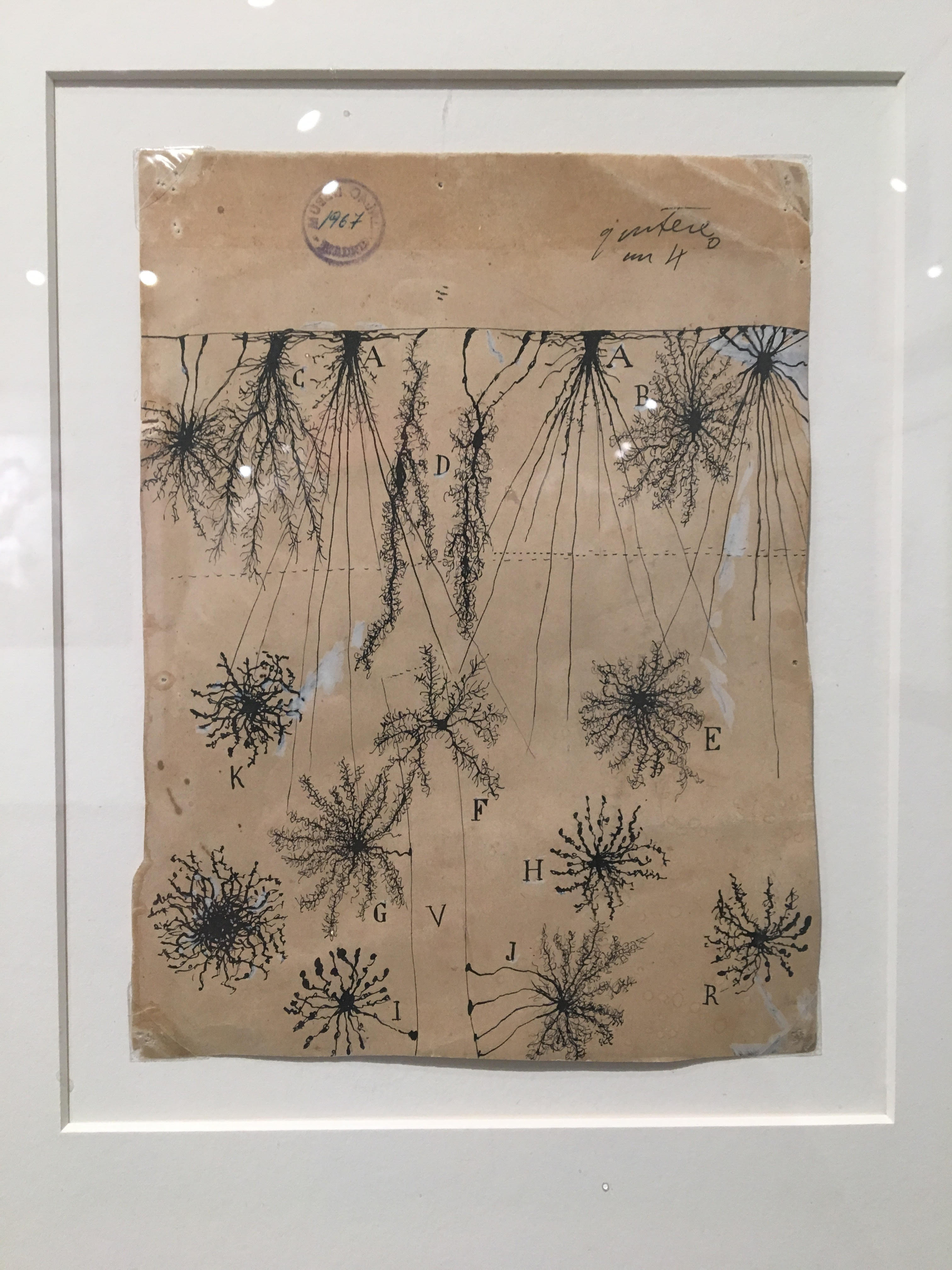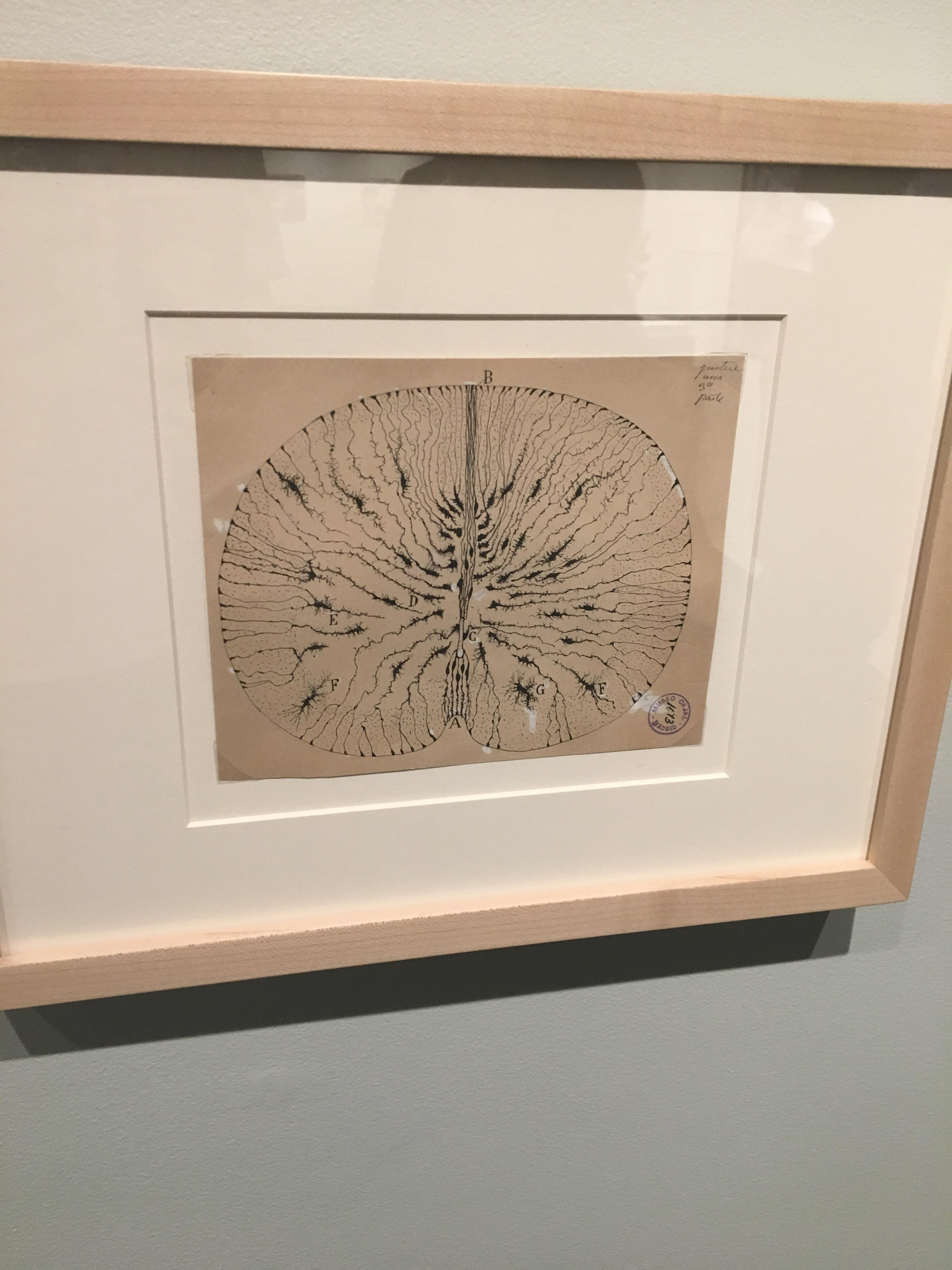 In “The Beautiful Brain: The Drawings of Santiago Ramón y Cajal” at MIT Museum, 80 drawings of brain and nervous system material by neurologist and artist Santiago Ramón y Cajal are on display. Many of the drawings were originally sketched in pencil and then traced over in black ink. Additional techniques employed by Cajal for these works include cross-hatching, ink washes, and watercolors. Many of the drawings are noted for their high level detail in representing microscopic neural cells and for their crucial role in the study of neuroscience. Lyndel King is the curator of the University of Minnesota’s Weisman Art Museum. King, along with the university’s revered neuroscientists, selected the 80 most aesthetically pleasing and scientifically significant drawings from Cajal’s substantial oeuvre.
In “The Beautiful Brain: The Drawings of Santiago Ramón y Cajal” at MIT Museum, 80 drawings of brain and nervous system material by neurologist and artist Santiago Ramón y Cajal are on display. Many of the drawings were originally sketched in pencil and then traced over in black ink. Additional techniques employed by Cajal for these works include cross-hatching, ink washes, and watercolors. Many of the drawings are noted for their high level detail in representing microscopic neural cells and for their crucial role in the study of neuroscience. Lyndel King is the curator of the University of Minnesota’s Weisman Art Museum. King, along with the university’s revered neuroscientists, selected the 80 most aesthetically pleasing and scientifically significant drawings from Cajal’s substantial oeuvre.
The exhibit’s location being a science museum gave me the expectation of having less room to critically interpret the artwork; these works function specifically as scientific research through the eyes of a groundbreaking neurologist. But Cajal was still a young artist at heart who had continued creating artwork throughout his adulthood of medical studies, and thus his creative expressions of his observations come with an artistic fingerprint. Degas viewed dancers, and Monet water lilies in such a way that most would rather view them through those artists’ lens than through a more realistic depiction like a photograph. Viewing brain cells as depicted by Cajal means viewing them through the first mind to ever see them so vividly.
Despite the consistency in their function, the drawings’ style, themes, and substance do vary. My companion during one trip to the exhibit described the drawing Glial cells of the cerebral cortex of a child (1904) as “spider snowflakes”. Having thought the same piece reminiscent of Cape Cod seaweed from the Nantucket Sound, I was surprised at the stark differences in our interpretation of an image that had already been observed and recreated so meticulously by the artist. The museum blurb engraved beside the piece seemed to have its own idea yet:
“It is easy to think of the starbursts of a fireworks display when looking at the astrocytes in this drawing. Cajal’s sense of artistic composition as well as his skill in scientific drawing facilitates this kind of association.”
When viewing Glial cells of the mouse spinal cord (1899), my friend observed a lima bean whereas I saw a drawing of an entire electrified brain receiving shock pulses. On the other hand, a drawing of star-shaped astrocyte cells is more unanimously accepted to be Cajal’s playful comparison of the cells to a group of little penguins.
Known in the scientific community as the father of modern neuroscience, Cajal was once a precocious Spanish adolescent with a passion for painting and art. He was dissuaded from such a free-spirited life by his strict father, and he took an interest in medicine after fighting in the Ten Years’ War in Cuba where he contracted tuberculosis and malaria. A genius scientist, Cajal made Nobel prize-winning improvements to a method of staining neurons, which had been previously difficult to distinguish even through a microscope. He marked these new images with thousands of highly detailed drawings that forever changed the way we can view the nervous system
The Beautiful Brain embraces the individuality and variability of artistic interpretation, even in a scientific context, with its drawing station. In the corner of the exhibit is a backlit table with paper, mechanical pencils, and microscopic photos of neurons and brain matter which museum guests are invited to draw their own pictures of to take home. Not only does the Cajal exhibit allow us to view Cajal’s discoveries through his mind, but it allows us to view them through our own too, whether we’re a Nobel prize-winning scientific pioneer or a clever young observer with an interest in the aesthetics of the world around us.
~
“The Beautiful Brain: The Drawings of Santiago Ramón y Cajal” is on display at the MIT Museum in Cambridge now through December 31. Admission is $5 for students / $10 for the general public. *Note: The MIT Museum participates in Bank of America’s Museums on Us program providing free admission to BoA cardholders on the first Saturday & Sunday of every month.




